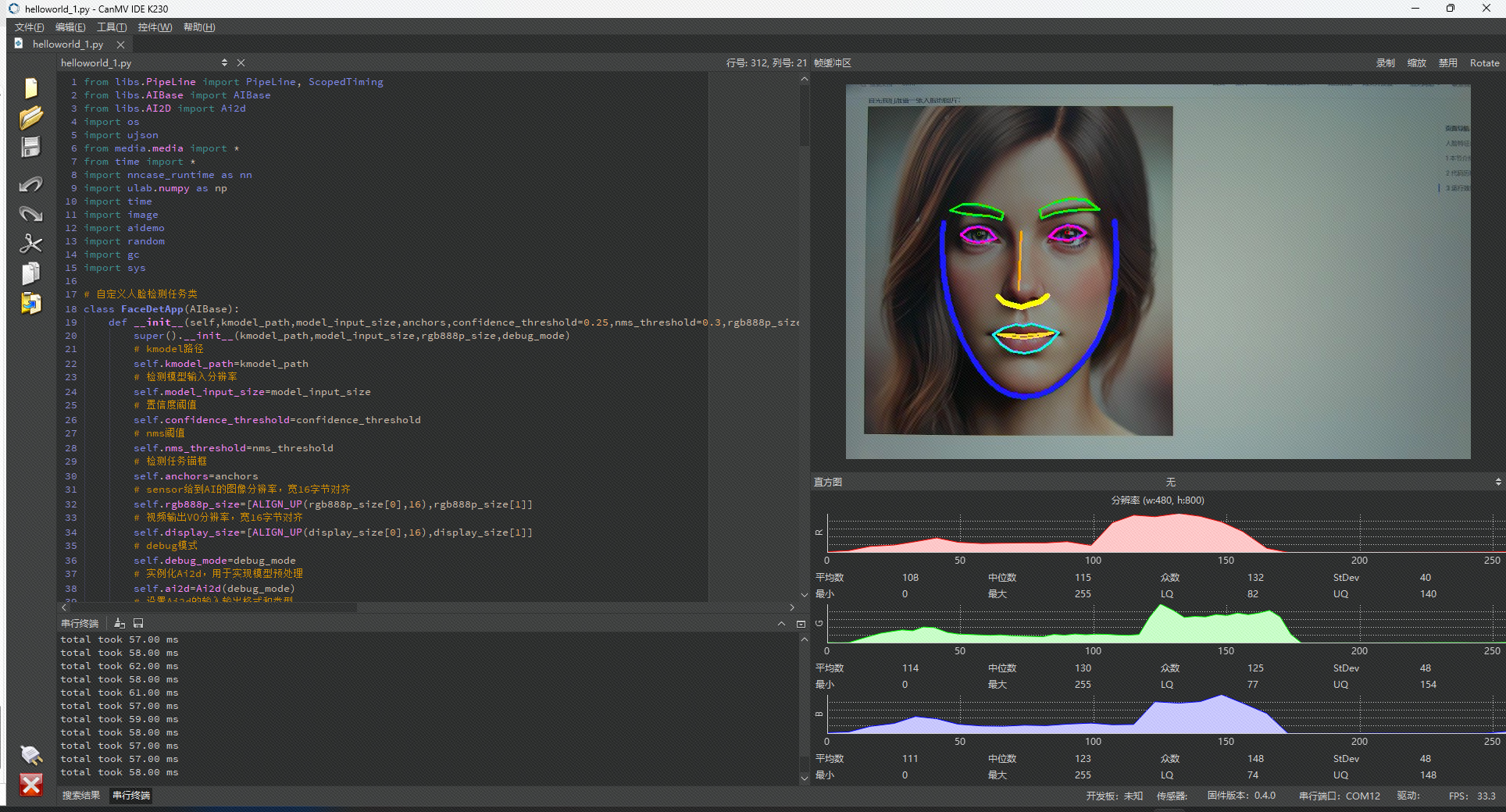1 本节介绍
📝本节您将学习如何通过庐山派来识别人脸的面部关键点,如无特殊说明,以后所有例程的显示设备均为通过外接立创·3.1寸屏幕扩展板,在3.1寸小屏幕上显示。若用户无3.1寸屏幕扩展板也可以正常在IDE的缓冲区,只是受限于USB带宽,可能会帧率较低或卡顿。
🏆学习目标
1️⃣如何用庐山派开发板去识别人脸并将眼睛、鼻子、嘴巴、头发等分割出来。
庐山派开发板的固件是存储在TF中的,模型文件已经提前写入到固件中了,所以大家只需要复制下面的代码到IDE,传递到开发板上就可以正常运行了。无需再额外拷贝,至于后面需要拷贝自己训练的模型那就是后话了。
脸特征点识别的主要工作是检测并定位人脸图像上的特定关键点(如眼睛、鼻子、嘴巴、下巴等)。这些关键点用于描述面部的几何结构,可以为后续的任务(比如面部表情识别提供支持。
2 代码历程
python
from libs.PipeLine import PipeLine, ScopedTiming
from libs.AIBase import AIBase
from libs.AI2D import Ai2d
import os
import ujson
from media.media import *
from time import *
import nncase_runtime as nn
import ulab.numpy as np
import time
import image
import aidemo
import random
import gc
import sys
# 自定义人脸检测任务类
class FaceDetApp(AIBase):
def __init__(self,kmodel_path,model_input_size,anchors,confidence_threshold=0.25,nms_threshold=0.3,rgb888p_size=[1280,720],display_size=[1920,1080],debug_mode=0):
super().__init__(kmodel_path,model_input_size,rgb888p_size,debug_mode)
# kmodel路径
self.kmodel_path=kmodel_path
# 检测模型输入分辨率
self.model_input_size=model_input_size
# 置信度阈值
self.confidence_threshold=confidence_threshold
# nms阈值
self.nms_threshold=nms_threshold
# 检测任务锚框
self.anchors=anchors
# sensor给到AI的图像分辨率,宽16字节对齐
self.rgb888p_size=[ALIGN_UP(rgb888p_size[0],16),rgb888p_size[1]]
# 视频输出VO分辨率,宽16字节对齐
self.display_size=[ALIGN_UP(display_size[0],16),display_size[1]]
# debug模式
self.debug_mode=debug_mode
# 实例化Ai2d,用于实现模型预处理
self.ai2d=Ai2d(debug_mode)
# 设置Ai2d的输入输出格式和类型
self.ai2d.set_ai2d_dtype(nn.ai2d_format.NCHW_FMT,nn.ai2d_format.NCHW_FMT,np.uint8, np.uint8)
# 配置预处理操作,这里使用了pad和resize,Ai2d支持crop/shift/pad/resize/affine,具体代码请打开/sdcard/app/libs/AI2D.py查看
def config_preprocess(self,input_image_size=None):
with ScopedTiming("set preprocess config",self.debug_mode > 0):
# 初始化ai2d预处理配置,默认为sensor给到AI的尺寸,可以通过设置input_image_size自行修改输入尺寸
ai2d_input_size=input_image_size if input_image_size else self.rgb888p_size
# 设置padding预处理
self.ai2d.pad(self.get_pad_param(), 0, [104,117,123])
# 设置resize预处理
self.ai2d.resize(nn.interp_method.tf_bilinear, nn.interp_mode.half_pixel)
# 构建预处理流程,参数为预处理输入tensor的shape和预处理输出的tensor的shape
self.ai2d.build([1,3,ai2d_input_size[1],ai2d_input_size[0]],[1,3,self.model_input_size[1],self.model_input_size[0]])
# 自定义后处理,results是模型输出的array列表,这里使用了aidemo的face_det_post_process列表
def postprocess(self,results):
with ScopedTiming("postprocess",self.debug_mode > 0):
res = aidemo.face_det_post_process(self.confidence_threshold,self.nms_threshold,self.model_input_size[0],self.anchors,self.rgb888p_size,results)
if len(res)==0:
return res
else:
return res[0]
# 计算padding参数
def get_pad_param(self):
dst_w = self.model_input_size[0]
dst_h = self.model_input_size[1]
# 计算最小的缩放比例,等比例缩放
ratio_w = dst_w / self.rgb888p_size[0]
ratio_h = dst_h / self.rgb888p_size[1]
if ratio_w < ratio_h:
ratio = ratio_w
else:
ratio = ratio_h
new_w = (int)(ratio * self.rgb888p_size[0])
new_h = (int)(ratio * self.rgb888p_size[1])
dw = (dst_w - new_w) / 2
dh = (dst_h - new_h) / 2
top = (int)(round(0))
bottom = (int)(round(dh * 2 + 0.1))
left = (int)(round(0))
right = (int)(round(dw * 2 - 0.1))
return [0,0,0,0,top, bottom, left, right]
# 自定义人脸关键点任务类
class FaceLandMarkApp(AIBase):
def __init__(self,kmodel_path,model_input_size,rgb888p_size=[1920,1080],display_size=[1920,1080],debug_mode=0):
super().__init__(kmodel_path,model_input_size,rgb888p_size,debug_mode)
# kmodel路径
self.kmodel_path=kmodel_path
# 关键点模型输入分辨率
self.model_input_size=model_input_size
# sensor给到AI的图像分辨率,宽16字节对齐
self.rgb888p_size=[ALIGN_UP(rgb888p_size[0],16),rgb888p_size[1]]
# 视频输出VO分辨率,宽16字节对齐
self.display_size=[ALIGN_UP(display_size[0],16),display_size[1]]
# debug模式
self.debug_mode=debug_mode
# 目标矩阵
self.matrix_dst=None
self.ai2d=Ai2d(debug_mode)
self.ai2d.set_ai2d_dtype(nn.ai2d_format.NCHW_FMT,nn.ai2d_format.NCHW_FMT,np.uint8, np.uint8)
# 配置预处理操作,这里使用了affine,Ai2d支持crop/shift/pad/resize/affine,具体代码请打开/sdcard/app/libs/AI2D.py查看
def config_preprocess(self,det,input_image_size=None):
with ScopedTiming("set preprocess config",self.debug_mode > 0):
# 初始化ai2d预处理配置,默认为sensor给到AI的尺寸,可以通过设置input_image_size自行修改输入尺寸
ai2d_input_size=input_image_size if input_image_size else self.rgb888p_size
# 计算目标矩阵,并获取仿射变换矩阵
self.matrix_dst = self.get_affine_matrix(det)
affine_matrix = [self.matrix_dst[0][0],self.matrix_dst[0][1],self.matrix_dst[0][2],
self.matrix_dst[1][0],self.matrix_dst[1][1],self.matrix_dst[1][2]]
# 设置仿射变换预处理
self.ai2d.affine(nn.interp_method.cv2_bilinear,0, 0, 127, 1,affine_matrix)
# 构建预处理流程,参数为预处理输入tensor的shape和预处理输出的tensor的shape
self.ai2d.build([1,3,ai2d_input_size[1],ai2d_input_size[0]],[1,3,self.model_input_size[1],self.model_input_size[0]])
# 自定义后处理,results是模型输出的array列表,这里使用了aidemo库的invert_affine_transform接口
def postprocess(self,results):
with ScopedTiming("postprocess",self.debug_mode > 0):
pred=results[0]
# (1)将人脸关键点输出变换模型输入
half_input_len = self.model_input_size[0] // 2
pred = pred.flatten()
for i in range(len(pred)):
pred[i] += (pred[i] + 1) * half_input_len
# (2)获取仿射矩阵的逆矩阵
matrix_dst_inv = aidemo.invert_affine_transform(self.matrix_dst)
matrix_dst_inv = matrix_dst_inv.flatten()
# (3)对每个关键点进行逆变换
half_out_len = len(pred) // 2
for kp_id in range(half_out_len):
old_x = pred[kp_id * 2]
old_y = pred[kp_id * 2 + 1]
# 逆变换公式
new_x = old_x * matrix_dst_inv[0] + old_y * matrix_dst_inv[1] + matrix_dst_inv[2]
new_y = old_x * matrix_dst_inv[3] + old_y * matrix_dst_inv[4] + matrix_dst_inv[5]
pred[kp_id * 2] = new_x
pred[kp_id * 2 + 1] = new_y
return pred
def get_affine_matrix(self,bbox):
# 获取仿射矩阵,用于将边界框映射到模型输入空间
with ScopedTiming("get_affine_matrix", self.debug_mode > 1):
# 从边界框提取坐标和尺寸
x1, y1, w, h = map(lambda x: int(round(x, 0)), bbox[:4])
# 计算缩放比例,使得边界框映射到模型输入空间的一部分
scale_ratio = (self.model_input_size[0]) / (max(w, h) * 1.5)
# 计算边界框中心点在模型输入空间的坐标
cx = (x1 + w / 2) * scale_ratio
cy = (y1 + h / 2) * scale_ratio
# 计算模型输入空间的一半长度
half_input_len = self.model_input_size[0] / 2
# 创建仿射矩阵并进行设置
matrix_dst = np.zeros((2, 3), dtype=np.float)
matrix_dst[0, 0] = scale_ratio
matrix_dst[0, 1] = 0
matrix_dst[0, 2] = half_input_len - cx
matrix_dst[1, 0] = 0
matrix_dst[1, 1] = scale_ratio
matrix_dst[1, 2] = half_input_len - cy
return matrix_dst
# 人脸标志解析
class FaceLandMark:
def __init__(self,face_det_kmodel,face_landmark_kmodel,det_input_size,landmark_input_size,anchors,confidence_threshold=0.25,nms_threshold=0.3,rgb888p_size=[1920,1080],display_size=[1920,1080],debug_mode=0):
# 人脸检测模型路径
self.face_det_kmodel=face_det_kmodel
# 人脸标志解析模型路径
self.face_landmark_kmodel=face_landmark_kmodel
# 人脸检测模型输入分辨率
self.det_input_size=det_input_size
# 人脸标志解析模型输入分辨率
self.landmark_input_size=landmark_input_size
# anchors
self.anchors=anchors
# 置信度阈值
self.confidence_threshold=confidence_threshold
# nms阈值
self.nms_threshold=nms_threshold
# sensor给到AI的图像分辨率,宽16字节对齐
self.rgb888p_size=[ALIGN_UP(rgb888p_size[0],16),rgb888p_size[1]]
# 视频输出VO分辨率,宽16字节对齐
self.display_size=[ALIGN_UP(display_size[0],16),display_size[1]]
# debug_mode模式
self.debug_mode=debug_mode
# 人脸关键点不同部位关键点列表
self.dict_kp_seq = [
[43, 44, 45, 47, 46, 50, 51, 49, 48], # left_eyebrow
[97, 98, 99, 100, 101, 105, 104, 103, 102], # right_eyebrow
[35, 36, 33, 37, 39, 42, 40, 41], # left_eye
[89, 90, 87, 91, 93, 96, 94, 95], # right_eye
[34, 88], # pupil
[72, 73, 74, 86], # bridge_nose
[77, 78, 79, 80, 85, 84, 83], # wing_nose
[52, 55, 56, 53, 59, 58, 61, 68, 67, 71, 63, 64], # out_lip
[65, 54, 60, 57, 69, 70, 62, 66], # in_lip
[1, 9, 10, 11, 12, 13, 14, 15, 16, 2, 3, 4, 5, 6, 7, 8, 0, 24, 23, 22, 21, 20, 19, 18, 32, 31, 30, 29, 28, 27, 26, 25, 17] # basin
]
# 人脸关键点不同部位(顺序同dict_kp_seq)颜色配置,argb
self.color_list_for_osd_kp = [
(255, 0, 255, 0),
(255, 0, 255, 0),
(255, 255, 0, 255),
(255, 255, 0, 255),
(255, 255, 0, 0),
(255, 255, 170, 0),
(255, 255, 255, 0),
(255, 0, 255, 255),
(255, 255, 220, 50),
(255, 30, 30, 255)
]
# 人脸检测实例
self.face_det=FaceDetApp(self.face_det_kmodel,model_input_size=self.det_input_size,anchors=self.anchors,confidence_threshold=self.confidence_threshold,nms_threshold=self.nms_threshold,rgb888p_size=self.rgb888p_size,display_size=self.display_size,debug_mode=0)
# 人脸标志解析实例
self.face_landmark=FaceLandMarkApp(self.face_landmark_kmodel,model_input_size=self.landmark_input_size,rgb888p_size=self.rgb888p_size,display_size=self.display_size)
# 配置人脸检测的预处理
self.face_det.config_preprocess()
# run函数
def run(self,input_np):
# 执行人脸检测
det_boxes=self.face_det.run(input_np)
landmark_res=[]
for det_box in det_boxes:
# 对每一个检测到的人脸解析关键部位
self.face_landmark.config_preprocess(det_box)
res=self.face_landmark.run(input_np)
landmark_res.append(res)
return det_boxes,landmark_res
# 绘制人脸解析效果
def draw_result(self,pl,dets,landmark_res):
pl.osd_img.clear()
if dets:
draw_img_np = np.zeros((self.display_size[1],self.display_size[0],4),dtype=np.uint8)
draw_img = image.Image(self.display_size[0], self.display_size[1], image.ARGB8888, alloc=image.ALLOC_REF,data = draw_img_np)
for pred in landmark_res:
# (1)获取单个人脸框对应的人脸关键点
for sub_part_index in range(len(self.dict_kp_seq)):
# (2)构建人脸某个区域关键点集
sub_part = self.dict_kp_seq[sub_part_index]
face_sub_part_point_set = []
for kp_index in range(len(sub_part)):
real_kp_index = sub_part[kp_index]
x, y = pred[real_kp_index * 2], pred[real_kp_index * 2 + 1]
x = int(x * self.display_size[0] // self.rgb888p_size[0])
y = int(y * self.display_size[1] // self.rgb888p_size[1])
face_sub_part_point_set.append((x, y))
# (3)画人脸不同区域的轮廓
if sub_part_index in (9, 6):
color = np.array(self.color_list_for_osd_kp[sub_part_index],dtype = np.uint8)
face_sub_part_point_set = np.array(face_sub_part_point_set)
aidemo.polylines(draw_img_np, face_sub_part_point_set,False,color,5,8,0)
elif sub_part_index == 4:
color = self.color_list_for_osd_kp[sub_part_index]
for kp in face_sub_part_point_set:
x,y = kp[0],kp[1]
draw_img.draw_circle(x,y ,2, color, 1)
else:
color = np.array(self.color_list_for_osd_kp[sub_part_index],dtype = np.uint8)
face_sub_part_point_set = np.array(face_sub_part_point_set)
aidemo.contours(draw_img_np, face_sub_part_point_set,-1,color,2,8)
pl.osd_img.copy_from(draw_img)
if __name__=="__main__":
# 显示模式,默认"hdmi",可以选择"hdmi"和"lcd"
display_mode="lcd"
# k230保持不变,k230d可调整为[640,360]
rgb888p_size = [1920, 1080]
if display_mode=="hdmi":
display_size=[1920,1080]
else:
display_size=[800,480]
# 人脸检测模型路径
face_det_kmodel_path="/sdcard/examples/kmodel/face_detection_320.kmodel"
# 人脸关键标志模型路径
face_landmark_kmodel_path="/sdcard/examples/kmodel/face_landmark.kmodel"
# 其它参数
anchors_path="/sdcard/examples/utils/prior_data_320.bin"
face_det_input_size=[320,320]
face_landmark_input_size=[192,192]
confidence_threshold=0.5
nms_threshold=0.2
anchor_len=4200
det_dim=4
anchors = np.fromfile(anchors_path, dtype=np.float)
anchors = anchors.reshape((anchor_len,det_dim))
# 初始化PipeLine,只关注传给AI的图像分辨率,显示的分辨率
pl=PipeLine(rgb888p_size=rgb888p_size,display_size=display_size,display_mode=display_mode)
pl.create()
flm=FaceLandMark(face_det_kmodel_path,face_landmark_kmodel_path,det_input_size=face_det_input_size,landmark_input_size=face_landmark_input_size,anchors=anchors,confidence_threshold=confidence_threshold,nms_threshold=nms_threshold,rgb888p_size=rgb888p_size,display_size=display_size)
try:
while True:
os.exitpoint()
with ScopedTiming("total",1):
img=pl.get_frame() # 获取当前帧
det_boxes,landmark_res=flm.run(img) # 推理当前帧
flm.draw_result(pl,det_boxes,landmark_res) # 绘制推理结果
pl.show_image() # 展示推理效果
gc.collect()
except Exception as e:
sys.print_exception(e)
finally:
flm.face_det.deinit()
flm.face_landmark.deinit()
pl.destroy()1
2
3
4
5
6
7
8
9
10
11
12
13
14
15
16
17
18
19
20
21
22
23
24
25
26
27
28
29
30
31
32
33
34
35
36
37
38
39
40
41
42
43
44
45
46
47
48
49
50
51
52
53
54
55
56
57
58
59
60
61
62
63
64
65
66
67
68
69
70
71
72
73
74
75
76
77
78
79
80
81
82
83
84
85
86
87
88
89
90
91
92
93
94
95
96
97
98
99
100
101
102
103
104
105
106
107
108
109
110
111
112
113
114
115
116
117
118
119
120
121
122
123
124
125
126
127
128
129
130
131
132
133
134
135
136
137
138
139
140
141
142
143
144
145
146
147
148
149
150
151
152
153
154
155
156
157
158
159
160
161
162
163
164
165
166
167
168
169
170
171
172
173
174
175
176
177
178
179
180
181
182
183
184
185
186
187
188
189
190
191
192
193
194
195
196
197
198
199
200
201
202
203
204
205
206
207
208
209
210
211
212
213
214
215
216
217
218
219
220
221
222
223
224
225
226
227
228
229
230
231
232
233
234
235
236
237
238
239
240
241
242
243
244
245
246
247
248
249
250
251
252
253
254
255
256
257
258
259
260
261
262
263
264
265
266
267
268
269
270
271
272
273
274
275
276
277
278
279
280
281
282
283
284
285
286
287
288
289
290
291
292
293
294
295
296
297
298
299
300
301
302
303
304
305
306
307
308
309
310
311
312
313
314
315
2
3
4
5
6
7
8
9
10
11
12
13
14
15
16
17
18
19
20
21
22
23
24
25
26
27
28
29
30
31
32
33
34
35
36
37
38
39
40
41
42
43
44
45
46
47
48
49
50
51
52
53
54
55
56
57
58
59
60
61
62
63
64
65
66
67
68
69
70
71
72
73
74
75
76
77
78
79
80
81
82
83
84
85
86
87
88
89
90
91
92
93
94
95
96
97
98
99
100
101
102
103
104
105
106
107
108
109
110
111
112
113
114
115
116
117
118
119
120
121
122
123
124
125
126
127
128
129
130
131
132
133
134
135
136
137
138
139
140
141
142
143
144
145
146
147
148
149
150
151
152
153
154
155
156
157
158
159
160
161
162
163
164
165
166
167
168
169
170
171
172
173
174
175
176
177
178
179
180
181
182
183
184
185
186
187
188
189
190
191
192
193
194
195
196
197
198
199
200
201
202
203
204
205
206
207
208
209
210
211
212
213
214
215
216
217
218
219
220
221
222
223
224
225
226
227
228
229
230
231
232
233
234
235
236
237
238
239
240
241
242
243
244
245
246
247
248
249
250
251
252
253
254
255
256
257
258
259
260
261
262
263
264
265
266
267
268
269
270
271
272
273
274
275
276
277
278
279
280
281
282
283
284
285
286
287
288
289
290
291
292
293
294
295
296
297
298
299
300
301
302
303
304
305
306
307
308
309
310
311
312
313
314
315
FaceDetApp(实现了人脸检测)
- 实现人脸检测功能,通过AI模型定位图像中的人脸,并返回人脸框的坐标。
FaceLandMarkApp(实现了人脸关键点检测)
- 实现人脸关键点检测功能,基于人脸检测的结果,进一步识别人脸关键点的具体位置。
在以上的代码中,主要是通过加载这两个AI模型来实现的,人脸检测模型和人脸关键点检测模型,就是先检测人脸,再到检测到人脸的区域去识别特定的关键点(眼睛,鼻子,嘴巴等)。
主要的流程就是先预处理(用AI2d库对图像进行调整,确保输入图像符合模型要求)->后处理(将模型输出的关键点坐标从模型的输入空间转换回实际图像坐标,方便展示)->结果绘制(把结果绘制到LCD屏幕上,标记出人脸关键点和轮廓)。
3 运行效果
首先我们准备一张人脸的图片:  在IDE中运行效果如下所示:
在IDE中运行效果如下所示: 